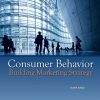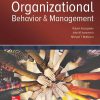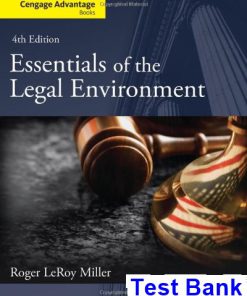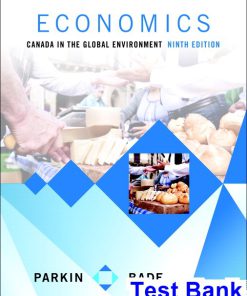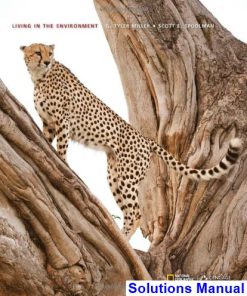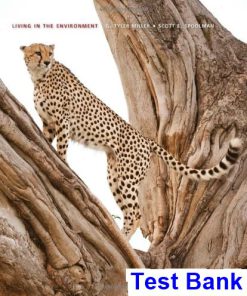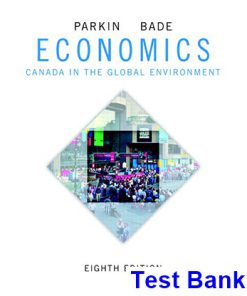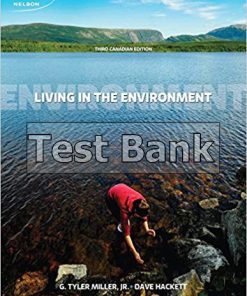Living in the Environment Canadian 4th Edition Miller Test Bank
$50.00 Original price was: $50.00.$26.50Current price is: $26.50.
Living in the Environment Canadian 4th Edition Miller Test Bank.
This is completed downloadable of Living in the Environment Canadian 4th Edition Miller Test Bank
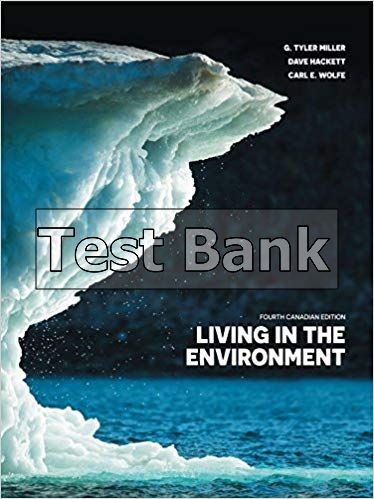
Product Details:
- ISBN-10 : 0176587187
- ISBN-13 : 978-0176587185
- Author: Carl Wolfe (Author) G. Miller (Author), Dave Hackett (Author) (Author)
Living in the Environment, Fourth Canadian Edition, is designed to equip students with the inspiration and knowledge they need to make a difference solving today’s environmental issues in Canada and globally. The text is science based, solutions oriented, and provides an interdisciplinary study of how nature works and how things in nature are interconnected. The authors present fair and balanced presentations of opposing viewpoints, advantages and disadvantages of various technologies, and proposed solutions to environmental problems without injecting personal bias, allowing students to think critically and draw their own conclusions about important environmental issues. With over 150 illustrations, maps, and animations, the text has been designed to present complex ideas in understandable ways that relate learning to the real world. Environmental issues are looked at from both Canadian and global perspectives, from the development of Alberta’s oil sands to reactions to the 2015 Paris Agreement on climate change. Comparisons and contrasts between North America and other countries such as China, India, Brazil, Nigeria, the Netherlands, and many more continue to be an important aspect to this fourth Canadian edition. Inspire all your students in the world of Environmental Science with Living in the Environment!
Table of Content:
- Part I: Humans and Sustainability: An Overview
- Chapter 1: Environmental Problems: An Introduction and Overview
- 1-1 Living More Sustainably
- 1-2 Population Growth, Economic Growth, Economic Development, and Globalization
- 1-3 Resources
- 1-4 Pollution
- 1-5 Environmental and Resource Problems: Causes and Connections
- 1-6 Is Our Present Course Sustainable?
- Chapter 2: Environmental History: Learning from the Past
- 2-1 Cultural Changes and the Environment
- 2-2 Environmental History of North America: Pre-Columbian Peoples and the Colonial Settlement Era
- 2-3 Environmental History of North America: The Early Conservation Era (1832-1960)
- 2-4 Environmental History of North America: The Environmental Era (1960 to the Present)
- 2-5 Where Do We Stand Now?
- Part II: Science and Ecological Principles
- Chapter 3: Science, Systems, Matter, and Energy
- 3-1 The Nature of Science
- 3-2 Models and Behaviour of Systems
- 3-3 Matter
- 3-4 Energy
- 3-5 The Law of Conservation of Matter: A Rule We Cannot Break
- 3-6 Nuclear Changes
- 3-7 Energy Laws: Two Rules We Cannot Break
- 3-8 Matter and Energy Laws and Environmental Problems
- Chapter 4: Ecosystems: What Are They, and How Do They Work?
- 4–1 The Nature of Ecology
- 4-2 Abiotic Ecosystem Components: Earth’s Life-Support Systems
- 4-3 Biotic Ecosystem Components: Producers, Consumers, and Biodiversity
- 4-4 Characteristics of Ecosystems
- 4-5 Primary Productivity of Ecosystems
- 4-6 Soil: A Key Ecosystem
- 4-7 Matter Cycling In Ecosystems
- 4-8 How Do Ecologists Learn about Ecosystems?
- Chapter 5: Evolution and Biodiversity
- 5-1 Origins of Life
- 5-2 Evolution and Adaptation
- 5-3 Ecological Niches and Adaptation
- 5-4 Speciation, Extinction, and Biodiversity
- 5-5 What Is the Future of Evolution?
- Chapter 6: Climate and Terrestrial Biodiversity
- 6-1 Weather: A Brief Introduction
- 6-2 Climate: A Brief Introduction
- 6-3 Biomes: Climate and Life on Land
- 6-4 Desert Biomes
- 6-5 Grassland and Tundra Biomes
- 6-6 Forest Biomes
- 6-7 Mountain Biomes
- Chapter 7: Aquatic Biodiversity
- 7-1 Aquatic Environments
- 7-2 Saltwater Life Zones
- 7-3 Freshwater Life Zones
- Chapter 8: Community Ecology
- 8-1 Community Structure and Species
- 8-2 Types of Species
- 8-3 Species Interactions: Competition and Predation
- 8-4 Species Interactions: Parasitism, Mutualism, and Commensalism
- 8-5 Ecological Succession: Communities in Transition
- 8-6 Ecological Stability, Complexity, and Sustainability
- Chapter 9: Population Ecology
- 9-1 Population Dynamics and Carrying Capacity
- 9-2 Reproductive Patterns and Survival
- 9-3 Effects of Genetic Variations on Population Size
- 9-4 Human Impacts on Natural Systems: Taking Stock
- Chapter 10: Applying Population Ecology: The Human Population
- 10-1 Factors Affecting Human Population Size
- 10-2 Population Age Structure
- 10-3 Solutions: Influencing Population Size
- 10-4 Case Studies: India and China
- 10-5 Cutting Global Population Growth
- Part III: Sustaining Biodiversity
- Chapter 11: Sustaining Terrestrial Biodiversity: Managing and Protecting Ecosystems
- 11-1 Human Impacts on Terrestrial Biodiversity
- 11-2 Conservation Biology
- 11-3 Public Lands in Canada
- 11-4 Managing and Sustaining Forests
- 11-5 Forest Resources and Management in Canada
- 11-6 Tropical Deforestation
- 11-7 National Parks
- 11-8 Nature Reserves
- 11-9 Ecological Restoration
- 11-10 What Can We Do?
- Chapter 12: Sustaining Biodiversity: The Species Approach
- 12-1 Species Extinction
- 12-2 Importance of Wild Species
- 12-3 Extinction Threats from Habitat Loss and Degradation
- 12-4 Extinction Threats from Non-native Species
- 12-5 Extinction Threats from Poaching and Hunting
- 12-6 Other Extinction Threats
- 12-7 Protecting Wild Species: The Research and Legal Approach
- 12-8 COSEWIC’s Five Risk Categories: Some Canadian Examples
- 12-9 Protecting Wild Species: The Sanctuary Approach
- 12-10 Reconciliation Ecology
- Chapter 13: Sustaining Aquatic Biodiversity
- 13-1 An Overview of Aquatic Biodiversity
- 13-2 Human Impacts on Aquatic Biodiversity
- 13-3 Protecting and Sustaining Marine Biodiversity
- 13-4 Managing and Sustaining the World’s Marine Fisheries
- 13-5 Protecting, Sustaining, and Restoring Lakes and Rivers
- 13-6 Protecting, Sustaining, and Restoring Wetlands
- Part IV: Sustaining Natural Resources
- Chapter 14: Food and Soil Resources
- 14-1 Food Production
- 14-2 Producing Food By Green Revolution and Traditional Techniques
- 14-3 Cropland Degradation and Erosion
- 14-4 Soil Conservation
- 14-5 Food Production, Nutrition, and Environmental Effects
- 14-6 Increasing Crop Production
- 14-7 Producing More Meat
- 14-8 Catching and Raising More Fish and Shellfish
- 14-9 Sustainable Agriculture
- Chapter 15: Water Resources
- 15-1 Water’s Importance and Unique Properties
- 15-2 Supply, Renewal, and Use of Water Resources
- 15-3 Too Little Water
- 15-4 Using Dams and Reservoirs to Supply More Water
- 15-5 Transferring Water from One Place to Another
- 15-6 Tapping Groundwater, Converting Salt Water to Fresh Water, Seeding Clouds, and Towing Icebergs
- 15-7 Reducing Water Waste
- 15-8 Too Much Water
- 15-9 A More Sustainable Water Future
- Chapter 16: Geology and Nonrenewable Mineral Resources
- 16-1 Geologic Processes
- 16-2 Internal and External Geologic Processes
- 16-3 Natural Geologic Hazards: Earthquakes and Volcanic Eruptions
- 16-4 Minerals, Rocks, and the Rock Cycle
- 16-5 Finding, Removing, and Processing Nonrenewable Mineral Resources
- 16-6 Environmental Effects of Using Mineral Resources
- 16-7 Supplies of Mineral Resources
- Chapter 17: Nonrenewable Energy Resources
- 17-1 Evaluating Energy Resources
- 17-2 Oil
- 17-3 Natural Gas
- 17-4 Coal
- 17-5 Nuclear Energy
- Chapter 18: Energy Efficiency and Renewable Energy
- 18-1 The Importance of Improving Energy Efficiency
- 18-2 Ways to Improve Energy Efficiency
- 18-3 Using Renewable Energy to Provide Heat and Electricity
- 18-4 Producing Electricity from the Water Cycle
- 18-5 Producing Electricity from Wind
- 18-6 Producing Energy from Biomass
- 18-7 Geothermal Energy
- 18-8 Hydrogen
- 18-9 Entering the Age of Decentralized Micropower
- 18-10 A Sustainable Energy Strategy
- Part V: Sustaining Environmental Quality
- Chapter 19: Risk, Toxicology, and Human Health
- 19-1 Risk, Probability, and Hazards
- 19-2 Toxicology: Assessing Chemical Hazards
- 19-3 Chemical Hazards
- 19-4 Biological Hazards: Disease in Developed and Developing Countries
- 19-5 Risk Analysis
- Chapter 20: Air Pollution
- 20-1 Structure and Science of the Atmosphere
- 20-2 Outdoor Air Pollution
- 20-3 Photochemical and Industrial Smog
- 20-4 Air Pollution from Acid Deposition
- 20-5 Indoor Air Pollution
- 20-6 Reducing and Preventing Air Pollution
- Chapter 21: Climate Change and Ozone Loss
- 21-1 Past Climate Change
- 21-2 The Earth’s Natural Greenhouse Effect
- 21-3 Climate Change and Human Activities
- 21-4 Projecting Future Changes in the Earth’s Temperature
- 21-5 Factors Affecting the Earth’s Temperature
- 21-6 Possible Effects of a Warmer World
- 21-7 Dealing With the Threat of Global Warming
- 21-8 What Is Being Done to Reduce Greenhouse Gas Emissions?
- 21-9 Ozone Depletion in the Stratosphere
- 21-10 Protecting the Ozone Layer
- Chapter 22: Water Pollution
- 22-1 Types, Effects, and Sources of Water Pollution
- 22-2 Pollution of Freshwater Streams
- 22-3 Pollution of Freshwater Lakes
- 22-4 Pollution of Groundwater
- 22-5 Ocean Pollution
- 22-6 Preventing and Reducing Surface Water Pollution
- 22-7 Drinking Water Quality
- Chapter 23: Pest Management
- 23-1 Pesticides: Types and Uses
- 23-2 The Case for Pesticides
- 23-3 The Case against Pesticides
- 23-4 Pesticide Regulation
- 23-5 Alternatives to Conventional Chemical Pesticides
- Chapter 24: Solid and Hazardous Waste
- 24-1 Wasting Resources
- 24-2 Producing Less Waste
- 24-3 Industrial Ecology and Selling Services Instead of Things
- 24-4 Reuse
- 24-5 Recycling
- 24-6 Burning and Burying Solid Waste
- 24-7 Hazardous Waste
- 24-8 Case Studies: Lead, Mercury, and Dioxins
- 24-9 Achieving a Low-Waste Society
- Chapter 25: Sustainable Cities
- 25-1 Urbanization and Urban Growth
- 25-2 Urban Resource and Environmental Problems
- 25-3 Transportation and Urban Development
- 25-4 Urban Land-Use Planning and Control
- 25-5 Making Urban Areas More Livable and Sustainable
- Part VI: Sustaining Human Societies
- Chapter 26: Economics, Environment, and Sustainability
- 26-1 Economic Resources and Systems
- 26-2 Economists’ Views of Pollution Control and Resource Management
- 26-3 Monitoring Environmental Progress
- 26-4 Harmful External Costs and Full-Cost Pricing
- 26-5 Ways to Improve Environmental Quality and Shift to Full-Cost Pricing
- 26-6 Reducing Poverty to Improve Environmental Quality and Human Well-Being
- 26-7 Making the Transition to More Environmentally Sustainable Economies
- Chapter 27: Politics, Environment, and Sustainability
- 27-1 Environmental and Political Challenges for This Century
- 27-2 Dealing with Environmental Problems in Democracies
- 27-3 Developing, Influencing, and Implementing Environmental Policy
- 27-4 Environmental Law
- 27-5 Environmental Groups and Their Opponents
- 27-6 Global Environmental Policy
- Chapter 28: Environmental Worldviews, Ethics, and Sustainability
- 28-1 Environmental Worldviews in Industrial Societies
- 28-2 Life-Centred and Earth-Centred Environmental Worldviews
- 28-3 Living More Sustainably
- Appendices
- Appendix 1: Units of Measure
- Appendix 2: Some Basic Chemistry
- Appendix 3: Continental Drift
- Appendix 4: Evolution and Time
- Appendix 5: Classifying and Naming Species
- Appendix 6: Brief History of the Age of Oil
- Appendix 7: Major Events in Environmental History
- Index
People Also Search:
living in the environment canadian miller
living in the environment canadian 4th edition miller
living in the environment canadian
living in the environment canadian 4th edition
living in the environment canadian 4th edition download scribd
miller living in the environment
living in the environment canadian 4th edition testbank download pdf
Instant download after Payment is complete
You may also like…
Humanities and Social Sciences
Living in the Environment 18th Edition Miller Solutions Manual
Humanities and Social Sciences
Solutions Manual
Living in the Environment 17th Edition Miller Solutions Manual
Solutions Manual
Living in the Environment 19th Edition Miller Solutions Manual


